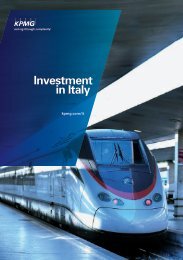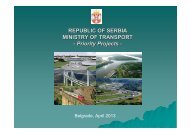Innovation Canada: A Call to Action
Innovation Canada: A Call to Action
Innovation Canada: A Call to Action
Create successful ePaper yourself
Turn your PDF publications into a flip-book with our unique Google optimized e-Paper software.
<strong>Innovation</strong> <strong>Canada</strong>: A <strong>Call</strong> <strong>to</strong> <strong>Action</strong>mind that stakeholders, by definition, havevested interests. They are beneficiaries of theprograms being discussed. Inevitably, somemay be excessively complimentary or critical,depending on individual objectives andexperience. Nevertheless, because the Panel’sconsultations — both in person and via writtensubmissions — were extensive and reasonablyrepresentative of the span of interests, it is likelythat the most oft-repeated views have goodgrounding in reality.ConsultationsThree federal programs that support R&Dwere most often mentioned in the Panel’sconsultations and survey: SR&ED tax credits, theIndustrial Research Assistance Program (IRAP)and, <strong>to</strong> a lesser extent, the Natural Sciencesand Engineering Research Council’s (NSERC)suite of business-facing programs in support ofinternships, networking and collaboration.Some corporate stakeholders called the SR&EDprogram and IRAP the lifelines that saved theirbusinesses; without them, their companieswould have foundered.The SR&ED program, in view of its scale andscope, drew considerable commentary. Muchwas positive: the program is seen <strong>to</strong> encouragenew investment in R&D, offset the high cost ofexplora<strong>to</strong>ry work, directly support operations,generate cash flow, and facilitate access <strong>to</strong>credit, while leaving the specific choice of R&Dactivity up <strong>to</strong> the individual business. At thesame time, reflecting the fact that it is the bestknown of the programs being reviewed, theSR&ED program also drew more criticalcommentary than any other R&D program.Many stakeholders called the claims processcumbersome, complex and time-consuming.Uncertainties associated with qualification andtiming are sometimes so great that the SR&EDprogram is excluded from R&D investmentdecisions. Many smaller businesses find theclaims process so unwieldy that they are forced<strong>to</strong> engage SR&ED “consultants,” sometimessurrendering significant percentages of theirrefunds as contingency fees. (These issues, aswell as the striking preponderance of SR&ED taxcredits in the <strong>to</strong>tal mix of business R&D support,are addressed in detail in Chapter 6.)IRAP was widely praised as an effective, well-runprogram that provides industry with nonrepayablecontributions, men<strong>to</strong>rship andtechnical business advice. The main criticism isthe exhaustion of funds very early in the fiscalyear, but this is also one indication of the highlevel of demand for the program. Some believethat the amounts of IRAP funding awardsare <strong>to</strong>o small <strong>to</strong> be effective and that theapplication process is excessively difficult forfirst-time applicants.A frequently raised issue was the need for moreefficient and targeted collaboration betweenpost-secondary institutions and businesses,particularly as it relates <strong>to</strong> mobilizing academiccontributions for commercialization. NSERC’scurrent suite of industry-facing programs isextensive, but is not well known by thepopulation of firms it is meant <strong>to</strong> support.Those stakeholders who were aware of NSERCprograms were generally pleased with them.Others, however, urged that the programs bemarketed more widely, because businessesoften do not know that they can access R&Dthrough post-secondary institutions. Thisproblem is clearly related <strong>to</strong> the small scale ofmost of NSERC’s business-facing programsand reduces their overall impact. The Panelemphasizes that, although program budgetsmay be fully subscribed, it is still important forthe programs <strong>to</strong> be widely known in order <strong>to</strong>attract more applicants. The selection processwould then be more competitive, leading <strong>to</strong>better overall outcomes for any given programbudget.Regarding the supply of graduates and theirskills, the Panel heard that businesses require a5-4
















